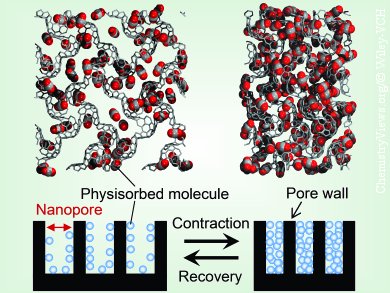Nanoporous materials, such as zeolites, activated carbons, and metal–organic frameworks (MOFs), are of interest for applications where guest molecules are stored, reacted, and/or separated. Examples include adsorbents, separation media, catalysts and catalyst supports, and electrodes. In such applications, control of the pore size is important because the pore size governs the physical properties and functions of the materials, for example, adsorption capability, diffusion rate, and molecular sieving. Conventionally, the size of the pores is controlled during synthesis.
Hirotomo Nishihara and colleagues, Tohoku University, Japan, have demonstrated a new way of controlling the pore size by applying mechanical force to soft nanoporous materials. The nanopores contract, and the physisorption potential is increased, on application of a mechanical force to a nanoporous material.
The team demonstrated that this simple and innovative method gives continuous and reversible control of the pore size of zeolite-templated carbon (ZTC). They found that the original pore size of ZTC (1.2 nm) could be shrunk by 71 %, to 0.85 nm, by a relatively weak force of 135 MPa. Upon contraction, the amount of CO2 adsorption was increased owing to the deepening of the physisorption potential well inside the micropores. Moreover, when the mechanical force was released, CO2 adsorption returned to the original amount, indicating the fully reversible contraction and recovery of the ZTC framework against mechanical force.
- Reversible Pore Size Control of Elastic Microporous Material by Mechanical Force,
Masashi Ito, Hirotomo Nishihara, Kentaro Yamamoto, Hiroyuki Itoi, Hideki Tanaka, Akira Maki, Minoru T. Miyahara, Seung Jae Yang, Chong Rae Park, Takashi Kyotani,
Chem. Eur. J. 2013.
DOI: 10.1002/chem.201301806



